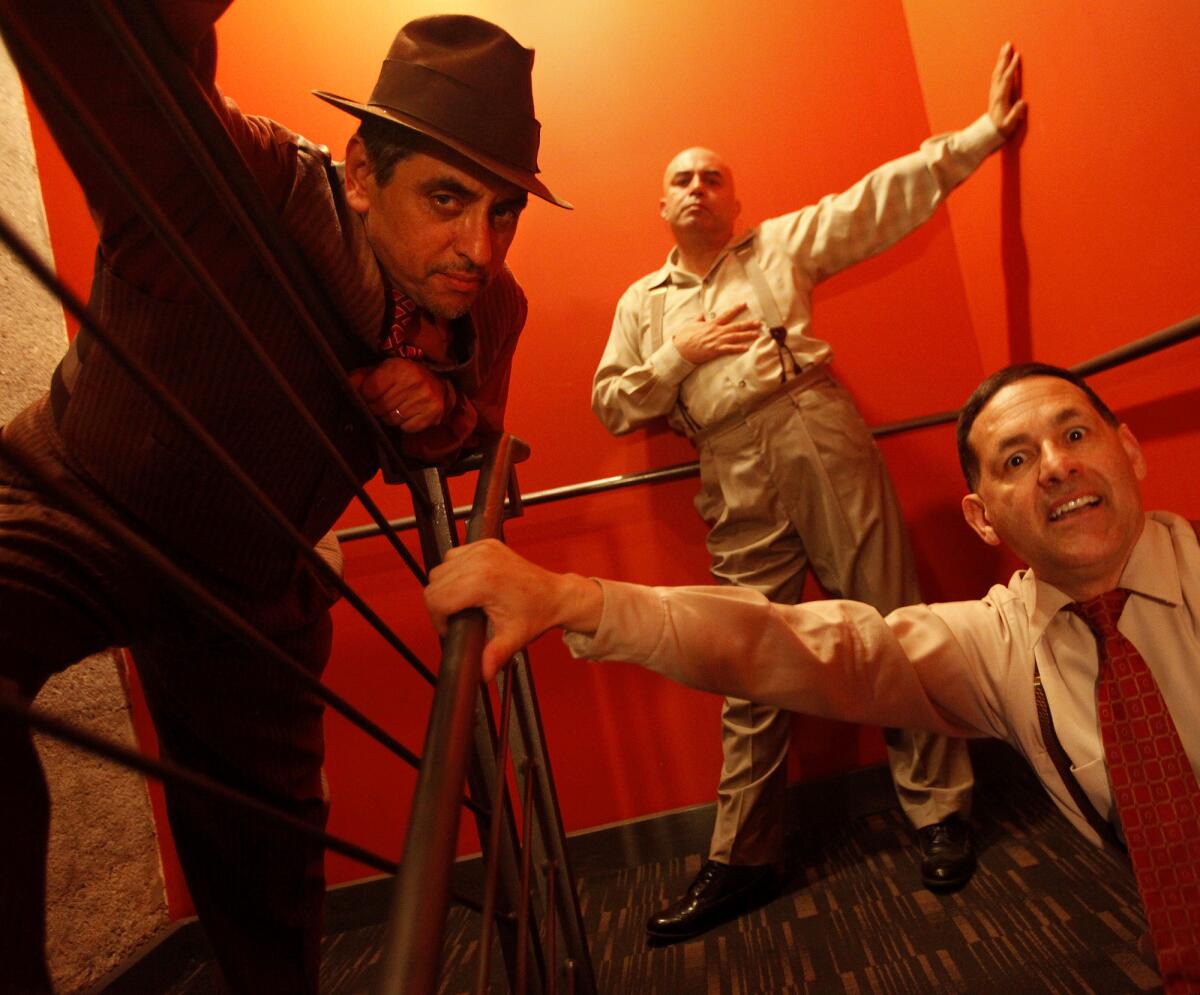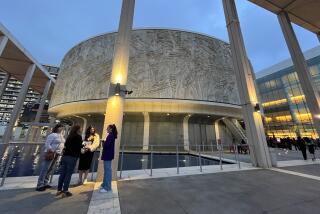Culture Clash adds more bite in ‘Chavez Ravine: An L.A. Revival’

The clickety-clack of an old-timey film projector fills the Kirk Douglas Theatre as grainy, black-and-white footage depicting Los Angeles, 1959, scrolls across the back wall of the stage. Police sweep through Chavez Ravine, home to villages of Mexican Americans; a woman is forcibly carried out of her home, held over the shoulders of officers like a construction log. In another clip: A lone shack is bulldozed, collapsing like a child’s rickety art project.
Suddenly, there’s a violent crack — a police baton? The theater fills with light and the uproarious cheers of a baseball stadium. The crack of a bat reverberates. We are in Dodger Stadium, circa 1981.
So begins this scene of “Chavez Ravine: An L.A. Revival,” an update to the seminal work by the three-person Latino theater group Culture Clash. The play first graced the stage of the Mark Taper Forum in 2003 and is seeing a revival open Feb. 4 at the Kirk Douglas, on the occasion of the group’s 30th anniversary.
During a tech rehearsal last week Richard Montoya, Ric Salinas and Herbert Siguenza stand quietly in their individual corners of the stage as spotlights and sound cues are tweaked at length and an acoustic guitar prattles in the background. Three decades performing together will do that: bring on patience. But the group, known as much for its Chicano arts activism as for staging political and social satire, insists that it has decidedly not mellowed with age.
“We’ve sharpened our satirical fangs and have more bite now than ever before,” Salinas says.
Based on historical documents and personal interviews, “Chavez Ravine” retells the story of how, in the 1950s, 315 acres adjacent to downtown L.A. — home to the villages of La Loma, Bishop and Palo Verde — were taken by eminent domain to build a Richard Neutra-designed public housing project. City politics thwarted the development, and the land instead became Dodger Stadium.
The play tackles gentrification, race and class divisions, urban power structures, McCarthyism, community identity and the search for home, among other issues. Though the L.A. production toured minimally and received mixed reviews in 2003 — “This ‘Ravine’ isn’t very deep,” Times reviewer Don Shirley said — it was a hit with audiences, the highest-grossing Taper play that season. Many consider it the group’s most important play.
“It’s the culmination of their first 20 years together, so it’s the most successful synthesis of their documentary techniques, their clowning impulses, their politics and their interest in telling stories that aren’t usually told,” says Lisa Peterson, who helmed the original production and is also directing the revival. “It’s had the most impact of all their plays because of the story they’re telling — the loss of a community and the mechanics of the city — and it’s told in such a nuanced way that we, in the end, can still celebrate the existence of Dodger Stadium.”
Bringing back “Chavez Ravine” now felt urgent, Montoya says.
“Watching the wholesale selling of our Mission District of San Francisco, Echo Park and Williamsburg [in Brooklyn] — it was time to reevaluate this idea of ‘the greater good’ and gentrification of our most unique neighborhoods in the country,” he says. “We wonder if any of the artists who helped create these great places can afford to live in them anymore. I mean, how many free-range foie gras places can Echo Park handle?”
Adds Siguenza: “It’s our best piece, as far as the collective voice, the most Culture Clash.”
L.A.’s institutional memory — or lack thereof — was another reason to restage the play, so that the story of Chavez Ravine doesn’t fade, Salinas says. “Angelenos have a bad case of cultural amnesia.”
This play, he says, is a history lesson.
The new production is less a traditional revival and more a reimagination by Culture Clash who, as in the original, perform most of the four dozen or so characters. While the narrative is the same — Dodger pitcher Fernando Valenzuela is visited on the field by the ghosts of Chavez Ravine’s past — the new incarnation is infused with multimedia. Historical video and photo projections have been culled from photo essayist Don Normark’s “Chavez Ravine, 1949: A Los Angeles Story,” as well as the Getty Research Institute and the digital archives of UCLA and USC, among other places. They scroll across five screens around the theater, providing an immersive feel. Live Chicano folk music is performed by the Rodarte Brothers and Vaneza Mari Calderón. About 30 minutes has been cut from the original production, which was criticized for being too long, and characters were eliminated to quicken the pace.
An old-fashioned radio drama, in tandem with the more intimate and immediate-feeling dramatic sketches, has been added. It’s a narrative device that not only amplifies the so-called movers and shakers dominating the airwaves, as Montoya puts it, but takes the group out of the spotlight and puts actress Sabina Zuniga Varela — the only outside performer in the play — front and center as the protagonist, Maria.
At one point in the play, Zuniga Varela and Salinas — as Maria and her brother, Henry — act out a scene in their Chavez Ravine home, arguing over whether to sell the house to the city.
“It’s about generosity, passing on the torch. We realize we need to yield the floor to that younger generation of Chicano actors out there,” Montoya says. “So we wrote ourselves out of key moments to make that room.”
Like many outsider artists, the group that formed in an art gallery in San Francisco’s Mission District on Cinco De Mayo, 1984, takes issue with labels — in its case, being called a “comedy troupe.” The members feel it’s an oversimplification that doesn’t convey their layered roles as writers, directors and performers of ethnographic theater that’s a mash-up of styles, careening between slapstick, sketch comedy, satire and heartfelt drama with live musical elements. They’re an activist performance group, they say, educating as much as entertaining their audience.
The new version of “Chavez Ravine” has elements of film noir, Abbott & Costello, comedian Louis C.K., the playwright August Wilson and Cheech & Chong, not to mention Woody Allen.
“What Woody Allen does is so specifically Jewish,” Salinas says, “but sometimes the subject matter hits the heart, whether you’re black, white or Asian.”
“Chavez Ravine” is geographically specificyet broad in appeal, and that’s key for the play, says UCLA assistant professor David G. Garcia, whose 2006 dissertation was about Culture Clash.
“It tells a very often ignored or little known history about a major city like Los Angeles — and it’s told from the perspective of the marginalized,” Garcia says. “It’s a common theme. We see the displacement of communities throughout the country, so it’s also universal.”
“Chavez” is Culture Clash’s seventh production at CTG along with “Water & Power,” “Carpa Clash” and “Palestine, New Mexico,” among others. It will undoubtedly play differently at the much smaller Kirk Douglas, but the relocation isn’t without its advantages.
“Being on Bunker Hill, we were in the shadow of City Hall, the opera, the cathedral and the Water and Power building, the power structure of Los Angeles,” Siguenza says. “But the Kirk Doulas Theatre is more intimate, and the audience will be surrounded by the play there.”
Adds Montoya: “Having downtown in the rearview mirror — that distance, is helpful.”
Three decades of partnership between the men, all in their 50s now, hasn’t precluded individual projects. Siguenza’s solo show, “A Weekend With Pablo Picasso,” which he wrote and stars in, heads to the Arizona Theatre Company this spring; Salinas has been touring with Paul S. Flores’ play “Placas,” in which he stars; and the film version of “Water & Power” that Montoya wrote and directed was released on digital platforms such as Netflix and Hulu in conjunction with the Sundance Film Festival.
The group’s core mission, however, remains the same — even after more than 5,000 performances, and even as the world around it morphs.
“We’re still social commentators using satire to expose the heavy subjects of sexism, homophobia, machismo, Chicano identity, the difference between the brown rainbow — Puerto Rican vs. Cuban vs. Mexican vs. South American and American Latinos,” Salinas says. “We put a voice on the voiceless, the people who live on the fringes.”
Siguenza adds that as he’s gotten older, “my politics and anger have gotten sharper. I truly believe the world is out of control, priorities are wrong, nationalism and religion have taken over and we are all divided. It might have to be artists that shout out some clarity.”
Twitter: @debvankin
------------
‘Chavez Ravine: An L.A. Revival’
Where: Kirk Douglas Theatre, 9820 W. Washington Blvd., Culver City
When: 8 p.m. Tuesdays-Fridays; 2 and 8 p.m. Saturdays; 1 and 6:30 p.m. Sundays. Through March 1.
Tickets: $25-$65
Info: (213) 628-2772; centertheatregroup.org
More to Read
The biggest entertainment stories
Get our big stories about Hollywood, film, television, music, arts, culture and more right in your inbox as soon as they publish.
You may occasionally receive promotional content from the Los Angeles Times.







